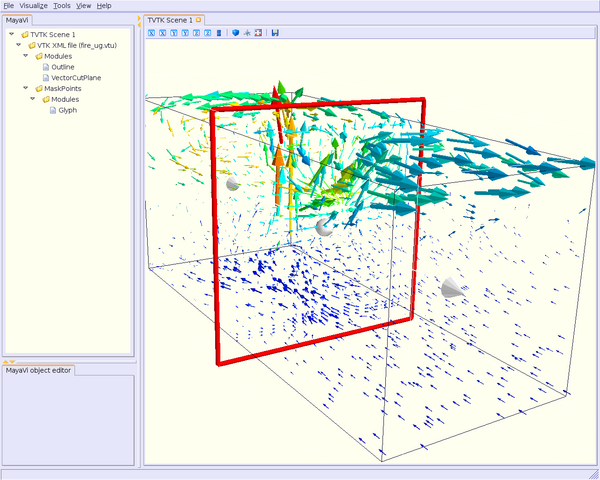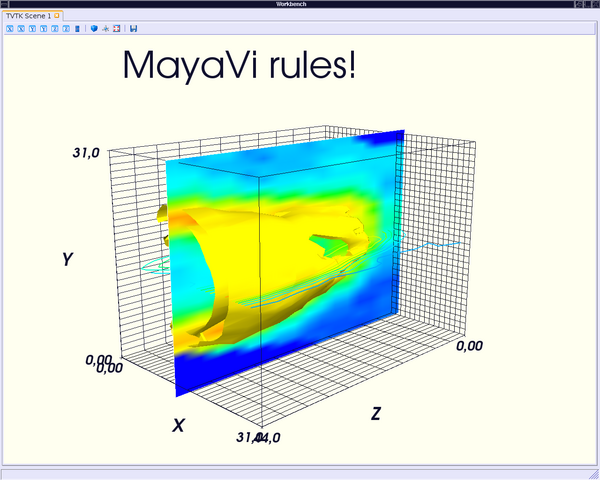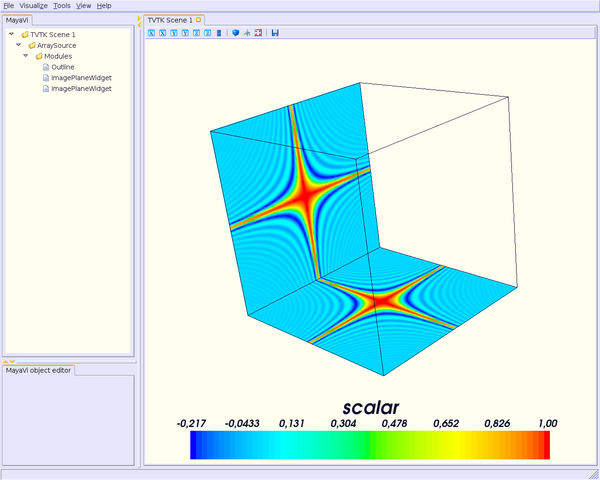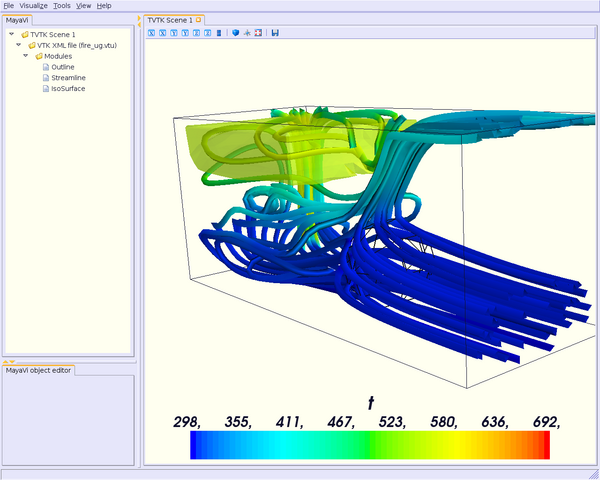Mayavi:示例¶
| 日期 | 2017-07-13(最后修改),2006-06-19(创建) |
|---|
||\<#80FF80> 本页面介绍使用高级面向对象 API 编写 Mayavi2 脚本。Mayavi2 最近获得了一个易于使用的脚本模块:mlab,虽然可能没有那么强大。欢迎参考 部分 的 Mayavi2 用户指南。 ||
简介¶
这里,将向您展示一些使用 !MayaVi2 可以获得的渲染场景示例。建议您阅读 [:Cookbook/MayaVi/ScriptingMayavi2] 以了解您所看到的内容,尽管这里给出的大多数示例都是不言自明的。
||\<#FF8080> 请注意,这些示例不是最新的。最新版 Mayavi 的示例库可以在 http://enthought.github.com/mayavi/mayavi/auto/examples.html 找到。 ||
使用等值面模块的示例(contour.py)¶
在 [ ]
#!/usr/bin/env mayavi2
"""This script demonstrates how one can script MayaVi and use its
contour related modules. Notice the magic line at the top.
"""
# Author: Prabhu Ramachandran <prabhu_r@users.sf.net>
# Copyright (c) 2005-2007, Enthought, Inc.
# License: BSD Style.
# Standard library imports
from os.path import join, dirname
# Enthought library imports
import enthought.mayavi
from enthought.mayavi.sources.vtk_file_reader import VTKFileReader
from enthought.mayavi.filters.threshold import Threshold
from enthought.mayavi.modules.outline import Outline
from enthought.mayavi.modules.grid_plane import GridPlane
from enthought.mayavi.modules.contour_grid_plane import ContourGridPlane
from enthought.mayavi.modules.iso_surface import IsoSurface
from enthought.mayavi.modules.scalar_cut_plane import ScalarCutPlane
def contour():
"""The script itself. We needn't have defined a function but
having a function makes this more reusable.
"""
# 'mayavi' is always defined on the interpreter.
# Create a new scene.
mayavi.new_scene()
# Read a VTK (old style) data file.
r = VTKFileReader()
r.initialize(join(dirname(enthought.mayavi.__file__),
'examples', 'data', 'heart.vtk'))
mayavi.add_source(r)
# Create an outline for the data.
o = Outline()
mayavi.add_module(o)
# Create three simple grid plane modules.
# First normal to 'x' axis.
gp = GridPlane()
mayavi.add_module(gp)
# Second normal to 'y' axis.
gp = GridPlane()
mayavi.add_module(gp)
gp.grid_plane.axis = 'y'
# Third normal to 'z' axis.
gp = GridPlane()
mayavi.add_module(gp)
gp.grid_plane.axis = 'z'
# Create one ContourGridPlane normal to the 'x' axis.
cgp = ContourGridPlane()
mayavi.add_module(cgp)
# Set the position to the middle of the data.
cgp.grid_plane.position = 15
# Another with filled contours normal to 'y' axis.
cgp = ContourGridPlane()
mayavi.add_module(cgp)
# Set the axis and position to the middle of the data.
cgp.grid_plane.axis = 'y'
cgp.grid_plane.position = 15
cgp.contour.filled_contours = True
# An isosurface module.
iso = IsoSurface(compute_normals=True)
mayavi.add_module(iso)
iso.contour.contours = [220.0]
# An interactive scalar cut plane.
cp = ScalarCutPlane()
mayavi.add_module(cp)
cp.implicit_plane.normal = 0,0,1
if __name__ == '__main__':
contour()

使用 Glyph 模块的示例(glyph.py)¶
在 [ ]
#!/usr/bin/env mayavi2
"""This script demonstrates the use of a VectorCutPlane, splitting the
pipeline using a MaskPoints filter and then viewing the filtered data
with the Glyph module.
"""
# Author: Prabhu Ramachandran <prabhu_r@users.sf.net>
# Copyright (c) 2005-2007, Enthought, Inc.
# License: BSD Style.
# Standard library imports
from os.path import join, dirname
# Enthought library imports
import enthought.mayavi
from enthought.mayavi.sources.vtk_xml_file_reader import VTKXMLFileReader
from enthought.mayavi.modules.outline import Outline
from enthought.mayavi.modules.glyph import Glyph
from enthought.mayavi.modules.vector_cut_plane import VectorCutPlane
from enthought.mayavi.modules.vectors import Vectors
from enthought.mayavi.filters.mask_points import MaskPoints
def glyph():
"""The script itself. We needn't have defined a function but
having a function makes this more reusable.
"""
# 'mayavi' is always defined on the interpreter.
# Create a new VTK scene.
mayavi.new_scene()
# Read a VTK (old style) data file.
r = VTKXMLFileReader()
r.initialize(join(dirname(enthought.mayavi.__file__),
'examples', 'data', 'fire_ug.vtu'))
mayavi.add_source(r)
# Create an outline and a vector cut plane.
mayavi.add_module(Outline())
v = VectorCutPlane()
mayavi.add_module(v)
v.glyph.color_mode = 'color_by_scalar'
# Now mask the points and show glyphs (we could also use
# Vectors but glyphs are a bit more generic)
m = MaskPoints()
m.filter.set(on_ratio=10, random_mode=True)
mayavi.add_filter(m)
g = Glyph()
mayavi.add_module(g)
# Note that this adds the module to the filtered output.
g.glyph.scale_mode = 'scale_by_vector'
# Use arrows to view the scalars.
g.glyph.glyph_source = g.glyph.glyph_list[1]
if __name__ == '__main__':
glyph()

没有 Mayavi2 UI 的示例(nongui.py)¶
在 [ ]
#!/usr/bin/env python
"""This script demonstrates how one can use the MayaVi framework
without displaying MayaVi's UI. Note: look at the end of this file to
see how the non gui plugin is chosen instead of the default gui
mayavi plugin.
"""
# Author: Prabhu Ramachandran <prabhu_r@users.sf.net>
# Copyright (c) 2005, Enthought, Inc.
# License: BSD Style.
# On systems with multiple wx installations installed, pick one that works
# with the libraries Mayavi depends on.
try:
import wxversion
wxversion.ensureMinimal('2.6')
except ImportError:
pass
# Standard library imports
import sys
from os.path import join, dirname
# Enthought library imports
from enthought.mayavi.app import Mayavi, NONGUI_PLUGIN_DEFINITIONS
class MyApp(Mayavi):
def run(self):
"""This is executed once the application GUI has started.
*Make sure all other MayaVi specific imports are made here!*
"""
# Various imports to do different things.
from enthought.mayavi.sources.vtk_file_reader import VTKFileReader
from enthought.mayavi.modules.outline import Outline
from enthought.mayavi.modules.axes import Axes
from enthought.mayavi.modules.grid_plane import GridPlane
from enthought.mayavi.modules.image_plane_widget import ImagePlaneWidget
from enthought.mayavi.modules.text import Text
from enthought.mayavi.modules.contour_grid_plane import ContourGridPlane
from enthought.mayavi.modules.iso_surface import IsoSurface
script = self.script
# Create a new scene.
script.new_scene()
# Read a VTK (old style) data file.
r = VTKFileReader()
r.initialize('data/heart.vtk')
r.initialize(join(dirname(__file__), 'data', 'heart.vtk'))
script.add_source(r)
# Put up some text.
t = Text(text='MayaVi rules!', x_position=0.2, y_position=0.9, width=0.8)
t.property.color = 1, 1, 0 # Bright yellow, yeah!
script.add_module(t)
# Create an outline for the data.
o = Outline()
script.add_module(o)
# Create an axes for the data.
a = Axes()
script.add_module(a)
# Create three simple grid plane modules.
# First normal to 'x' axis.
gp = GridPlane()
script.add_module(gp)
# Second normal to 'y' axis.
gp = GridPlane()
gp.grid_plane.axis = 'y'
script.add_module(gp)
# Third normal to 'z' axis.
gp = GridPlane()
script.add_module(gp)
gp.grid_plane.axis = 'z'
# Create one ImagePlaneWidget.
ipw = ImagePlaneWidget()
script.add_module(ipw)
# Set the position to the middle of the data.
ipw.ipw.slice_position = 16
# Create one ContourGridPlane normal to the 'x' axis.
cgp = ContourGridPlane()
script.add_module(cgp)
# Set the position to the middle of the data.
cgp.grid_plane.axis = 'y'
cgp.grid_plane.position = 15
# An isosurface module.
iso = IsoSurface(compute_normals=True)
script.add_module(iso)
iso.contour.contours = [200.0]
# Set the view.
s = script.engine.current_scene
cam = s.scene.camera
cam.azimuth(45)
cam.elevation(15)
s.render()
if __name__ == '__main__':
m = MyApp()
# Note how we change the plugins that are loaded only here.
m.main(plugin_defs=NONGUI_PLUGIN_DEFINITIONS)

使用 3D 数组作为数值源的示例 (numeric_source.py)¶
在 [ ]
#!/usr/bin/env mayavi2
"""This script demonstrates how to create a numpy array data and
visualize it as image data using a few modules.
"""
# Author: Prabhu Ramachandran <prabhu_r@users.sf.net>
# Copyright (c) 2005-2007, Enthought, Inc.
# License: BSD Style.
# Standard library imports
import enthought.util.scipyx as scipy
# Enthought library imports
from enthought.mayavi.sources.array_source import ArraySource
from enthought.mayavi.modules.outline import Outline
from enthought.mayavi.modules.image_plane_widget import ImagePlaneWidget
def make_data(dims=(128, 128, 128)):
"""Creates some simple array data of the given dimensions to test
with."""
np = dims[0]*dims[1]*dims[2]
# Create some scalars to render.
x, y, z = scipy.ogrid[-5:5:dims[0]*1j,-5:5:dims[1]*1j,-5:5:dims[2]*1j]
x = x.astype('f')
y = y.astype('f')
z = z.astype('f')
scalars = (scipy.sin(x*y*z)/(x*y*z))
return scipy.transpose(scalars).copy() # This makes the data contiguous.
def view_numpy():
"""Example showing how to view a 3D numpy array in mayavi2.
"""
# 'mayavi' is always defined on the interpreter.
mayavi.new_scene()
# Make the data and add it to the pipeline.
data = make_data()
src = ArraySource(transpose_input_array=False)
src.scalar_data = data
mayavi.add_source(src)
# Visualize the data.
o = Outline()
mayavi.add_module(o)
ipw = ImagePlaneWidget()
mayavi.add_module(ipw)
ipw.module_manager.scalar_lut_manager.show_scalar_bar = True
ipw_y = ImagePlaneWidget()
mayavi.add_module(ipw_y)
ipw_y.ipw.plane_orientation = 'y_axes'
if __name__ == '__main__':
view_numpy()

使用 Streamline 模块的示例 (streamline.py)¶
在 [ ]
#!/usr/bin/env mayavi2
"""This script demonstrates how one can script MayaVi to display
streamlines and an iso surface.
"""
# Author: Prabhu Ramachandran <prabhu_r@users.sf.net>
# Copyright (c) 2005-2007, Enthought, Inc.
# License: BSD Style.
# Standard library imports
from os.path import join, dirname
# Enthought library imports
from enthought.mayavi.sources.vtk_xml_file_reader import VTKXMLFileReader
from enthought.mayavi.modules.outline import Outline
from enthought.mayavi.modules.streamline import Streamline
from enthought.mayavi.modules.iso_surface import IsoSurface
def setup_data(fname):
"""Given a VTK XML file name `fname`, this creates a mayavi2
reader for it and adds it to the pipeline. It returns the reader
created.
"""
mayavi.new_scene()
r = VTKXMLFileReader()
r.initialize(fname)
mayavi.add_source(r)
return r
def streamline():
"""Sets up the mayavi pipeline for the visualization.
"""
# Create an outline for the data.
o = Outline()
mayavi.add_module(o)
s = Streamline(streamline_type='tube')
mayavi.add_module(s)
s.stream_tracer.integration_direction = 'both'
s.seed.widget.center = 3.5, 0.625, 1.25
s.module_manager.scalar_lut_manager.show_scalar_bar = True
i = IsoSurface()
mayavi.add_module(i)
i.contour.contours[0] = 550
i.actor.property.opacity = 0.5
if __name__ == '__main__':
import enthought.mayavi
fname = join(dirname(enthought.mayavi.__file__),
'examples', 'data', 'fire_ug.vtu')
r = setup_data(fname)
streamline()

使用 ImagePlaneWidget 模块的示例 (test.py)¶
在 [ ]
#!/usr/bin/env python
"""This script demonstrates how one can script MayaVi, set its size,
create a new VTK scene and create a few simple modules.
"""
# Author: Prabhu Ramachandran <prabhu_r@users.sf.net>
# Copyright (c) 2005, Enthought, Inc.
# License: BSD Style.
# On systems with multiple wx installations installed, pick one that works
# with the libraries Mayavi depends on.
try:
import wxversion
wxversion.ensureMinimal('2.6')
except ImportError:
pass
# Standard library imports
import sys
from os.path import join, dirname
# Enthought library imports
from enthought.mayavi.app import Mayavi
class MyApp(Mayavi):
def run(self):
"""This is executed once the application GUI has started.
*Make sure all other MayaVi specific imports are made here!*
"""
# Various imports to do different things.
from enthought.mayavi.sources.vtk_file_reader import VTKFileReader
from enthought.mayavi.filters.threshold import Threshold
from enthought.mayavi.modules.outline import Outline
from enthought.mayavi.modules.axes import Axes
from enthought.mayavi.modules.grid_plane import GridPlane
from enthought.mayavi.modules.image_plane_widget import ImagePlaneWidget
from enthought.mayavi.modules.text import Text
script = self.script
# Create a new scene.
script.new_scene()
# Read a VTK (old style) data file.
r = VTKFileReader()
r.initialize(join(dirname(__file__), 'data', 'heart.vtk'))
script.add_source(r)
# Put up some text.
t = Text(text='MayaVi rules!', x_position=0.2,
y_position=0.9, width=0.8)
t.property.color = 1, 1, 0 # Bright yellow, yeah!
script.add_module(t)
# Create an outline for the data.
o = Outline()
script.add_module(o)
# Create an axes for the data.
a = Axes()
script.add_module(a)
# Create an orientation axes for the scene. This only works with
# VTK-4.5 and above which is why we have the try block.
try:
from enthought.mayavi.modules.orientation_axes import OrientationAxes
except ImportError:
pass
else:
a = OrientationAxes()
a.marker.set_viewport(0.0, 0.8, 0.2, 1.0)
script.add_module(a)
# Create three simple grid plane modules.
# First normal to 'x' axis.
gp = GridPlane()
script.add_module(gp)
# Second normal to 'y' axis.
gp = GridPlane()
gp.grid_plane.axis = 'y'
script.add_module(gp)
# Third normal to 'z' axis.
gp = GridPlane()
script.add_module(gp)
gp.grid_plane.axis = 'z'
# Create one ImagePlaneWidget.
ipw = ImagePlaneWidget()
script.add_module(ipw)
# Set the position to the middle of the data.
ipw.ipw.slice_position = 16
if __name__ == '__main__':
a = MyApp()
a.main()
在 [ ]
#!/usr/bin/env mayavi2
"""Shows how to view data created by `enthought.tvtk.tools.mlab` with
mayavi2.
"""
# Author: Prabhu Ramachandran <prabhu@aero.iitb.ac.in>
# Copyright (c) 2006-2007, Enthought Inc.
# License: BSD Style.
import numpy
from enthought.tvtk.tools import mlab
from enthought.mayavi.sources.vtk_data_source import VTKDataSource
from enthought.mayavi.filters.warp_scalar import WarpScalar
from enthought.mayavi.modules.outline import Outline
from enthought.mayavi.modules.surface import Surface
def f(x, y):
"""Some test function.
"""
return numpy.sin(x*y)/(x*y)
def make_data():
"""Make some test numpy data and create a TVTK data object from it
that we will visualize.
"""
x = numpy.arange(-7., 7.05, 0.1)
y = numpy.arange(-5., 5.05, 0.05)
s = mlab.SurfRegular(x, y, f)
return s.data
def add_data(tvtk_data):
"""Add a TVTK data object `tvtk_data` to the mayavi pipleine.
"""
d = VTKDataSource()
d.data = tvtk_data
mayavi.add_source(d)
def surf_regular():
"""Now visualize the data as done in mlab.
"""
w = WarpScalar()
mayavi.add_filter(w)
o = Outline()
s = Surface()
mayavi.add_module(o)
mayavi.add_module(s)
if __name__ == '__main__':
mayavi.new_scene()
d = make_data()
add_data(d)
surf_regular()
章节作者:FredericPetit,Christian Gagnon
附件
